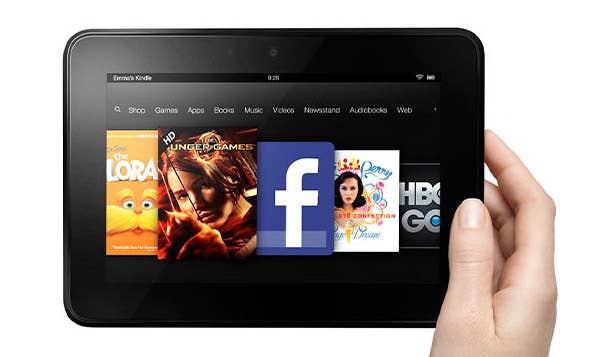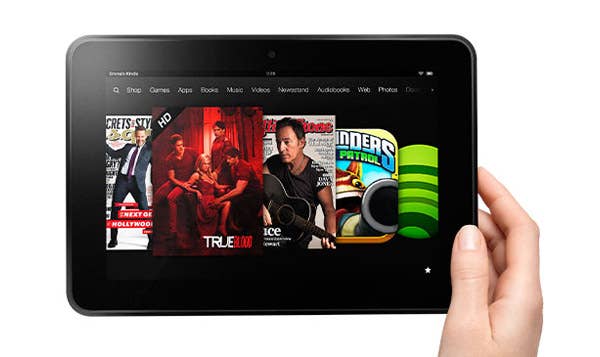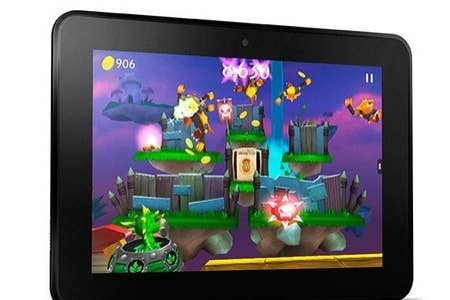Spec Analysis: The New Kindle Fire HD Tablets
Digital Foundry's assessment of the new Amazon slates' gaming prowess
Last year, while researching an iPad feature, an insider in the mobile industry told me that when the dust settles, the only major hardware manufacturers in the mobile market will be those with access to significant content libraries - Apple, Google and Amazon. Almost one year on, the source's prediction is beginning to look eerily accurate - in the tablet arena at least. iPad continues to rule the market, but Google - and now Amazon - have finally stepped up their efforts in challenging Apple's all-conquering slate. Suddenly, everything else is beginning to look rather over-priced and increasingly irrelevant in comparison.
Last week's announcement of the new Kindle Fire tablets shows a renewed focus from Amazon on their tablet range with products aimed squarely at competing with both the Nexus 7 and the iPad. The 7-inch Kindle Fire HD is an intriguing release similar to the Google slate in many ways, with just a small reshuffling in terms of spec: the high-power quad-core Tegra 3 is replaced by a dual-core TI OMAP processor, but the Kindle Fire HD offers twice the storage for the same price.
"Has Amazon stifled the gaming potential of its new tablets in order to accommodate its enticing price-points?"
There are other goodies too: specifically the inclusion of a Micro HDMI port that allows downloaded and streaming movies to run directly on an HDTV. Amazon also takes aim at the iPad by including proper stereo speakers in the unit, based on a collaboration with Dolby, no less - an interesting contrast to the mono-speaker technology found in Apple's tablet.
While display resolution is identical to the Nexus 7 at 1280x800 and using the same IPS technology for improved viewing angles, commentators have noted improved colour reproduction on the Amazon device, along with an improved anti-glare feature which goes some way in addressing the reflective issues on the Google tablet. Amazon is clearly taking media consumption seriously - this is a Kindle after all - and the firm clearly wants to give its hardware the best shot at working in as many different environments as possible.
However, the big concern with the tablet concerns the choice of its main processor: TI's OMAP 4460 SoC (system on chip) graces the 7-inch offering - the same chip found in the Galaxy Nexus Smartphone and in no way competitive with the likes of Tegra 3 or the A5 chip found in the iPhone 4S and iPad 2, let alone this year's A5X revision. The Nexus 7 tablet acquits itself as a decent games machine, but it's hard to imagine that the Fire HD can offer anything like the same experience: it'll almost certainly be fine for 2D titles, but based on our experience with equivalent hardware, it will definitely struggle with more advanced 3D games. The PowerVR SGX540 integrated into the Kindle Fire HD is very long in the tooth now - roughly equivalent to the now-outmoded Tegra 2 from NVIDIA.

The situation is improved significantly with the new 8.9-inch Fire HD, which sees Amazon upgrade the spec to a more capable OMAP 4470. It's still a dual-core part in terms of CPU power, but the GPU gets a decent upgrade - enough for firm boss Jeff Bezos to make the bold claim that the integrated PowerVR SGX544 actually has the better of Tegra 3. Certainly in terms of memory bandwidth and floating point operations, it's a white-wash, with the IMG chipset comprehensively out-performing the NVIDIA part. But the SGX544 is an older part, and TI is using a single graphics core rather than the multi-core arrangements found in the iPad.
Once again it's unlikely that high-end 3D apps will match the Tegra 3 tablets in terms of performance, especially bearing in mind the additional resolution the chipset services: NVIDIA's tech has typically been paired with 1280x800 screens, but with the Kindle Fire HD 8.9-inch, Amazon has gone for a full-on 1920x1200 resolution.
"Amazon's take on what its consumers want from a tablet is an interesting exercise in give and take, a downgrade in many ways compared to the iPad and Nexus 7, but with enough features to remain competitive"
Bearing in mind that this is mostly the preserve of 24-inch desktop displays, that's a hell of a lot of pixels crammed into a very small space - not quite of the "Retina"-level, but impressive nonetheless. Unfortunately, when it comes to gaming, more pixels requires more GPU power to maintain performance and it's difficult to imagine that the new Kindle holds a candle to the iPad 2 and "new iPad", where Apple has invested hugely in graphics power, and reaped the benefits.
Yet despite the substantial power differential, the 8.9-inch Kindle Fire HD (curiously, not coming to the UK yet, according to the Amazon UK website) looks like being the most credible challenger to the iPad - in terms of the larger form-factor at least - that we've seen. It retains all of the advantages of the 7-inch model - Dolby audio, HDMI output - and boasts a $299 pricepoint up against the $399 of the iPad 2 and the $499 of the new iPad. The 4G LTE version of Amazon's effort actually costs the same as the entry-level new iPad - a clear demarcation if ever there were one. The intent here seems clear: Amazon has nipped and tucked at the iPad spec while aiming for a similar experience, offering substantial price-cuts into the bargain, with spec improvements added where the firm feels it can actually surpass the iPad without an enormous hardware investment.
Overall then, Amazon's take on what its consumers want from a tablet is an interesting exercise in "give and take", a downgrade in many ways compared to the iPad and Nexus 7, but with enough features to remain competitive in terms of the core functionality, along with some additional thought - and spec - put into features that will perhaps take it beyond its competitors as a media consumption device.
However, in terms of our industry, it is a shame that the games credentials of the device are relatively weak: mobile faces a year of fundamental change, with the appearance of next-gen 28nm parts which will revolutionise the capabilities of next year's tablets and smartphones. In this sense, the "built to a budget" element of the Kindle devices is a little disappointing: games will be rapidly evolving on the mobile platform, potentially even becoming a target for AAA publishers, and the relative lack of power will lock out these new Kindles from this new wave of gaming.

Questions also need to be asked about the Amazon-specific iteration of the Android operating system developed for the new tablet. It's an extensively re-skinned version of Android 4.0 but without the speed/experience optimisations made in the new Jellybean revision of the OS found in the Nexus 7. Apple's iOS offerings perform well even on a dual-core processor, but even the new Google tablet isn't quite as smooth as the iPad 2 - despite featuring two more CPU cores. Hands-on tests of the Amazon version of the OS, while inconclusive, suggest that the user experience isn't as refined as either of its competitors, and tales of adverts being displayed on the lock-screen are unlikely to endear the device to its more hardcore users.
On the flipside, a number of new features have been added that take the Kindle Fire HD's media consumption abilities significantly beyond its competitors - X-Ray sees users able to access the internet for more information on actors, characters, places or events across both movies and books.
"Based on the older Android 4.0 OS and using less powerful processors, Amazon faces a tough challenge in matching the smoothness and response of its closest competitors in the tablet space"
WhisperSync allows Amazon customers to pick up their novels, games or films on other devices at exactly the same place that they left off. "Immersion Reading" even brings together text books with their audio counterparts, both running simultaneously, which Amazon reckons makes the process of absorbing content a lot easier. New Facebook and email clients are promised too - a move designed primarily to make Amazon content easier to share amongst friends.
And that's what is going to make or break the Kindle tablets' fortunes - the quality of Amazon's content. If there's one drawback to this device, it's that there's no access to the core Google Play site, meaning that for apps and games at least, one walled garden has been exchanged for another, somewhat smaller domain. The hacker community's response to this has been to root the existing Kindle Fire and manually add Google Play back in - a relatively simple procedure, but whether this will be possible with the next-gen Kindles remains to be seen. As for any potential impact to the success of the device, the excellent sales of existing Fire product suggest that, similar to the Nexus 7, the combination of a keenly priced piece of consumer electronics in concert with a recognised, trusted brand works well in attracting strong sales.
Crucially, there's little doubt that the new Fire HD products are enormous improvements over the original Amazon Android, with what look like some impressive new features. Amazon appears to have refined and significantly improved its existing, successful formula and these new Kindles will undoubtedly sell very well indeed. But where Apple and Google have produced rounded products with strong gaming credentials, Amazon's proposition is significantly more skewed towards giving customers better access to its own product lines - gaming provision comes across almost as if it is an afterthought, similar to iPhone in the early days. But the bottom line is that in producing a tablet so rich in functionality at such a cheap price, something had to give...









